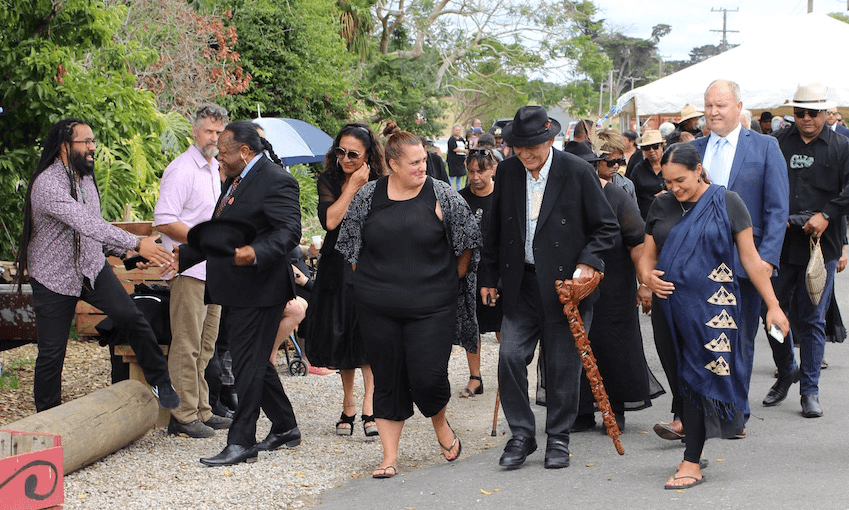On day 1,173 of the occupation at Ihumātao, it was announced that a resolution is imminent, and expected before Waitangi Day. Leonie Hayden reports from Māngere.
This morning Kiingi Tuheitia travelled to Ihumātao and lowered the flag of the Kiingitanga.
Six years after ancestral land at Ihumātao in Manukau was earmarked for a future housing development, and more than three years after an occupation by land protectors began, the lowering of the flag indicates a resolution has been reached. Details of an agreement are expected soon.
Rukumoana Schaafhausen, a spokesperson for the Kiingitanga, said that although they can’t confirm what the resolution is or when it will be revealed, they’re confident there will be an announcement before Waitangi commemorations.
“When the king arrived in August of last year the flag was erected in recognition of peace and unity… Today is a really positive day. The lowering of the flag is recognition that the king has successfully intervened in a process that will see a positive resolution.”
The king and his ope will continue on to Rātana from Ihumātao.
Auckland Council and the Crown have been in talks with Kiingitanga, who are speaking on behalf of all mana whenua parties, including land protection group SOUL, Te Kawerau a Maki and Makaurau marae.
After the ceremony, SOUL members Pania Newton, Qiane Matata-sipu, Ngāti Tahinga Wilson and Haki Wilson said they felt relieved.
“I think history will only tell what this kaupapa has entailed, but for us we hope that it encourages other people to stand up against injustice. To stand up against environmental degradation and to stand up for cultural heritage landscapes and our wāhi tapu and our history,” said Newton.
“We hope to heal some of the heartache that lays across this whenua. For us the first step is to get this whenua out of Fletchers hands and into … somewhere!”
A far cry from the sea of tents and bodies that occupied the whenua five months ago, and the lines of police that blocked the road leading to the Ōtuataua stonefields and the iwi’s ancestral maunga, today there remained only a handful of wooden structures.
“When you look down the road here and you see the fences have been removed, and there isn’t any Fletcher equipment left here on the whenua, that’s an indication to us that the resolution is really close.”
As for what happens after the land is returned into iwi hands, Matata-Sipu said those decisions will take time.
“I think people need to understand that this whenua has been out of iwi ownership since it was confiscated and to ask iwi what the future of this whenua looks like, you first have to allow iwi to breathe a little a bit. And allow iwi for the first time to be able to have dreams and aspirations.”
The contested land on the Manukau harbour near Auckland Airport was confiscated in 1863 as punishment for Ihumātao’s support of the Kiingitanga during the Waikato wars. The original settler family sold the land, which sits alongside the protected Ōtuatāua stonefields, in 2016 to Fletcher Residential for the development of 520 houses.
Mandated iwi groups Te Kawarau a Maki and Makaurau marae soon entered into mitigating negotiations with Fletchers, essentially giving iwi support to the development. In 2015 six cousins that whakapapa to the area formed SOUL to protect Ihumātao and stop the development, going head to head with some of their own whānau members.
The occupation, which started after a Parihaka celebration on November 5 2016, came to prominence in July 2019 when the land protectors occupying the site were issued with an eviction notice on behalf of Fletcher Residential. At the forefront of the campaign was Pania Newton, the young activist lawyer, who mobilised many hundreds of people in peaceful resistance that responded to the call for support, arriving from all over the country.
In July, Jacinda Ardern asked for all building work to be halted until a resolution could be found. The prime minister did not respond to repeated invitations to visit the occupied land.
In September, hope was glimpsed when the Kiingitanga stepped in to mediate talks between different stakeholders.
Read more:
The occupation of Ihumātao: week one
Our trail of tears: the story of Ihumātao
‘I’ve had my tangi’: Police descend on the occupants of Ihumātao
